

FUTL06.
The 6 Major Skills for 21st Century Students. January, 2015 Here is a short two pages PDF document from ISTE (International Society for Technology in Education) which features the six major fluencies (standards) students need to develop in the 21st century classroom.
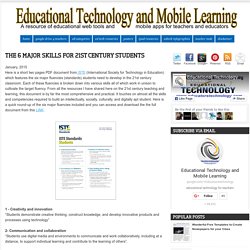
Each of these fluencies is broken down into various skills all of which work in unison to cultivate the target fluency. From all the resources I have shared here on the 21st century teaching and learning, this document is by far the most comprehensive and practical. It touches on almost all the skills and competencies required to build an intellectually, socially, culturally, and digitally apt student. Here is a quick round-up of the six major fluencies included and you can access and download the the full document from this LINK. 1 - Creativity and innovation “Students demonstrate creative thinking, construct knowledge, and develop innovative products and processes using technology” The Essential Elements of Digital Literacies.
Connected Learning and Digital Literacy. ~ Connectivism ~ A word which I’d never encountered before three weeks ago.

A theory which is beginning to make sense to me. An area I’m growing my confidence in. This is my current understanding of what it means: Connectivism is the next evolution of the learning “-isms”: behaviourism, cognitivism, constructivism. How to Infuse Digital Literacy Throughout the Curriculum. So how are we doing on the push to teach “digital literacy” across the K12 school spectrum?

From my perspective as a school-based technology coach and history teacher, I’d say not as well as we might wish – in part because our traditional approach to curriculum and instruction wants to sort everything into its place. Digital literacy is defined as “the ability to effectively and critically navigate, evaluate, and create information using a range of digital technologies.” Many educational and business professional cite is as a critical 21st century skill. Even so, many schools have struggled to adapt it into their curriculum. This is often because most institutions already have rigorous, established curricula with little wiggle room – and this is especially true in schools subject to state and federal testing. Evaluating online content is a research skill For example, when my students do research in US History, they are not only allowed but encouraged to use online content.
3 Knowledge Domains For The 21st Century Student. Thinking in the 21st century is just different.
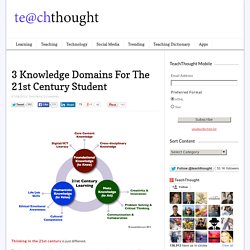
That doesn’t mean we’re all suddenly omnipotent cyborgs, nor does it mean we’ve all become mindless social media addicts that spend our cognitive might tapping, swiping, and drooling on our smartphone and tablet screens. But just as the 19th century presented unique challenges to information processing than the 18th or 20th, the 21st century is different than the one before, or that the one that will come after. punyamishra.com recently released the following graphic that I thought was interesting, mainly in that it identified knowledge types for modern learning, settling on Foundational, Humanistic, and Meta Knowledge. 3 Knowledge Domains For The 21st Century Student 1.
Digital/ICT Literacy, Core Content Knowledge, Cross-disciplinary Knowledge. 63 Things Every Student Should Know In A Digital World. 63 Things Every Student Should Know In A Digital World by Terry Heick It could be argued—and probably argued well—that what a student fundamentally needs to know today isn’t much different than what Tom Sawyer or Joan of Arc or Alexander the Great needed to know.

Communication. Resourcefulness. Creativity. Persistence. How true this turns out to be depends on how macro you want to get. But in an increasingly connected and digital world, the things a student needs to know are indeed changing—fundamental human needs sometimes drastically redressed for an alien modern world. 4 Principals Of Digital Literacy. Literacy.
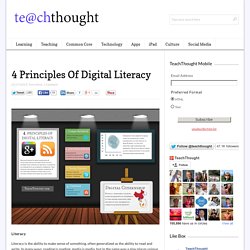
Digital Literacies & Learning Design. Digital Literacy and Education. Educational institutions are constantly synchronizing their curricula with digital literacy to maintain pace with burgeoning technology.
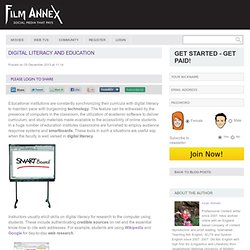
The feature can be witnessed by the presence of computers in the classroom, the utilization of academic software to deliver curriculum, and study materials made available to the accessibility of online students. In a huge number of education institutes classrooms are furnished to employ audience response systems and smartboards. Get Started with Microsoft Digital Literacy - Microsoft UK Faculty Connection. Whether you are new to computing or have some experience, Digital Literacy will help you develop a fundamental understanding of computers.

The courses help you learn the essential skills to begin computing with confidence, be more productive at home and at work, stay safe online, use technology to complement your lifestyle, and consider careers where you can put your skills to work.and click “go”, and you will be taken to the appropriate page. Choose your language English (UK) & Welsh both available The Microsoft Digital Literacy curriculum has three levels. The Basic curriculum features a course called A First Course Toward Digital Literacy. What The Data Says About Students' 21st Century Readiness. What The Data Says About Students’ 21st Century Readiness 21st century skills is a term that’s been bandied about for over a decade now.
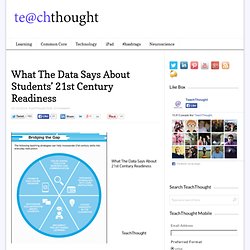
Loosely, it refers to the creative and technology-based skills students are increasingly required to demonstrate to use information in the real world. While there’s plenty of tools, leadership, strategies, and even rhetoric surrounding this discussion, what’s there’s less of is data. The following infographic from learning.com/21cs helps soften that reality a bit by graphically displaying the data from over 500,000 elementary and middle school assessments framed around ISTE’s technology standards. It then goes on to offer areas of strength (digital citizenship and technology operation) and weakness (research, critical thinking, problem solving). But hey, all is not lost. This number seem a bit high to anyone? Information-learning » Blog Archive » Model for Information Literacy.
Information Literacy. Information literacy: the work of librarians past and present. As long as there have been public libraries, librarians have been involved in education.

They have helped people choose what to read for leisure and helped with their information needs. The recent emphasis on information literacy is more of a new term than a new concept, but as technology has transformed everything in society, information literacy needs to be done differently. For most of the twentieth century, the best way for most people to identify books on a particular subject was the card catalog in the library. Specialists could use various published bibliographies or the Cumulative Book Index among other tools. Reader’s Guide to Periodical Literature, which began publication in 1905, helped the general public find information in magazines, etc. The foregoing describes the kinds of tools available up until the Internet went public. The online library catalog has replaced the card catalog. New online databases have replaced the Reader’s Guide. Image credit: Digitalliteracies-3. Exploring Curation as a core competency in digital and media literacy education.
Literacy-chart_0.jpg 600×457 Pixel. Digital Literacy and the Human Society. Digital literacy helps you communicate and keep pace with modern global developments. In the social media and network integration literacy not only gives people a platform to come into contact, share desired knowledge but also help them do business promotion and transactions. The idea is very frequently being adopted by the young generation by connecting via social media, e.g. LinkedIn, Facebook, etc.